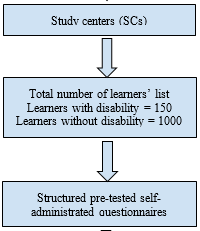Empowering SSC Learners with Disability at Bangladesh Open University through Open and Distance Learning
DOI:
https://doi.org/10.59738/jstr.v5i1.23(9-16).iwhq3481Abstract
Disabilities are a major problem that frequently causes affected people to be socially excluded in Bangladesh. Recognizing the value of inclusive education, Bangladesh's national strategy for 2010 placed a strong emphasis on the necessity of integrating excluded groups, such as people with disabilities, into the educational system. Open School (OS) of Bangladesh Open University plays an important aspect of educating a wide range of people who have not taken part in the traditional educational system. However, the nationwide broadness of these programs and the different entry-level characteristics of the participants complicate delivering effective education. Misconceptions often arise among learners regarding printed text materials and tutorial classes, exacerbating the situation. Furthermore, a lack of coordination makes these problems worse. This study attempts to investigate how learners with disabilities, including those with autism and physical disabilities, feel about these programs. It aims to pinpoint areas for improving program quality and offer insightful information about the socioeconomic circumstances and academic possibilities of students with disabilities. The research's findings are meant to help Bangladesh Open University's faculty, administrators, and policymakers improve and develop these programs for all students, regardless of their skills or limitations
Downloads

Published
How to Cite
Issue
Section
License
Copyright (c) 2024 Journal of Scientific and Technological Research

This work is licensed under a Creative Commons Attribution-NonCommercial 4.0 International License.






